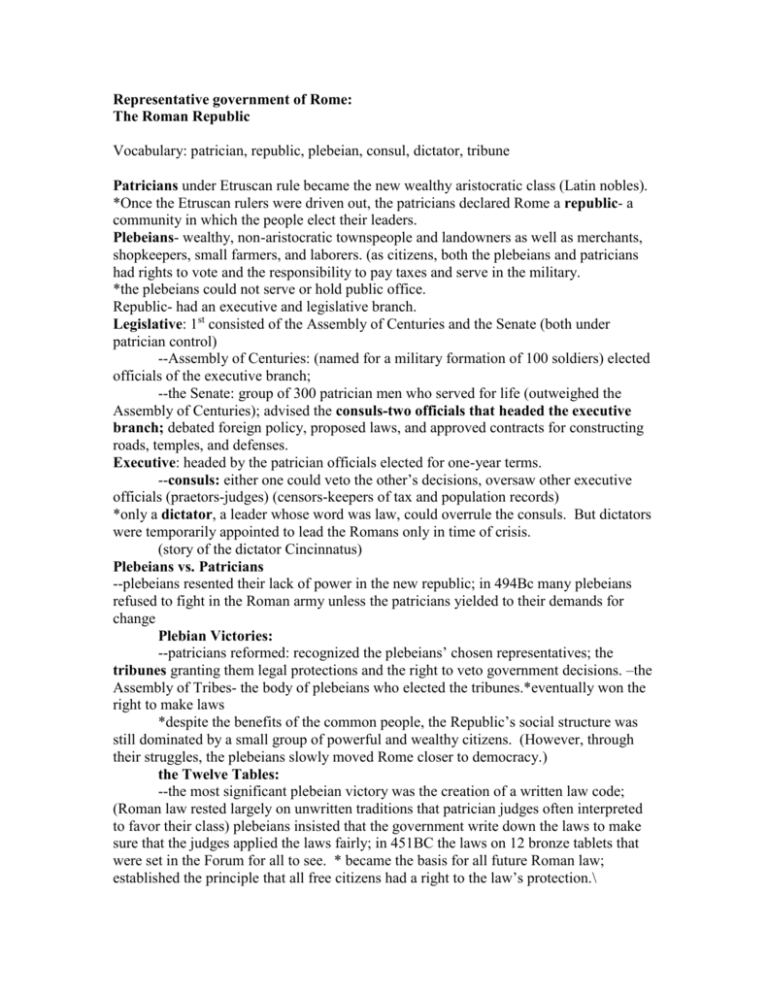Representative government of Rome:
advertisement

Representative government of Rome: The Roman Republic Vocabulary: patrician, republic, plebeian, consul, dictator, tribune Patricians under Etruscan rule became the new wealthy aristocratic class (Latin nobles). *Once the Etruscan rulers were driven out, the patricians declared Rome a republic- a community in which the people elect their leaders. Plebeians- wealthy, non-aristocratic townspeople and landowners as well as merchants, shopkeepers, small farmers, and laborers. (as citizens, both the plebeians and patricians had rights to vote and the responsibility to pay taxes and serve in the military. *the plebeians could not serve or hold public office. Republic- had an executive and legislative branch. Legislative: 1st consisted of the Assembly of Centuries and the Senate (both under patrician control) --Assembly of Centuries: (named for a military formation of 100 soldiers) elected officials of the executive branch; --the Senate: group of 300 patrician men who served for life (outweighed the Assembly of Centuries); advised the consuls-two officials that headed the executive branch; debated foreign policy, proposed laws, and approved contracts for constructing roads, temples, and defenses. Executive: headed by the patrician officials elected for one-year terms. --consuls: either one could veto the other’s decisions, oversaw other executive officials (praetors-judges) (censors-keepers of tax and population records) *only a dictator, a leader whose word was law, could overrule the consuls. But dictators were temporarily appointed to lead the Romans only in time of crisis. (story of the dictator Cincinnatus) Plebeians vs. Patricians --plebeians resented their lack of power in the new republic; in 494Bc many plebeians refused to fight in the Roman army unless the patricians yielded to their demands for change Plebian Victories: --patricians reformed: recognized the plebeians’ chosen representatives; the tribunes granting them legal protections and the right to veto government decisions. –the Assembly of Tribes- the body of plebeians who elected the tribunes.*eventually won the right to make laws *despite the benefits of the common people, the Republic’s social structure was still dominated by a small group of powerful and wealthy citizens. (However, through their struggles, the plebeians slowly moved Rome closer to democracy.) the Twelve Tables: --the most significant plebeian victory was the creation of a written law code; (Roman law rested largely on unwritten traditions that patrician judges often interpreted to favor their class) plebeians insisted that the government write down the laws to make sure that the judges applied the laws fairly; in 451BC the laws on 12 bronze tablets that were set in the Forum for all to see. * became the basis for all future Roman law; established the principle that all free citizens had a right to the law’s protection.\ Activity: October 3, 2001 Using the information from your notes and textbook, make a diagram that charts the Executive and Legislative branches of the Roman Republic. Include in your chart the development of the plebeians and the reforms of the patricians. Also, make a timeline that charts the early development of Rome and the Roman Republic. Timeline needs to include: Time period of the Indo-Europeans Time of Rule by the Etruscans The legend of Romulus and Remus The Tarquins drove out of Rome The Plebeians revolt The dictatorship of Cincinnatus The patricians engrave the Twelve Tables











